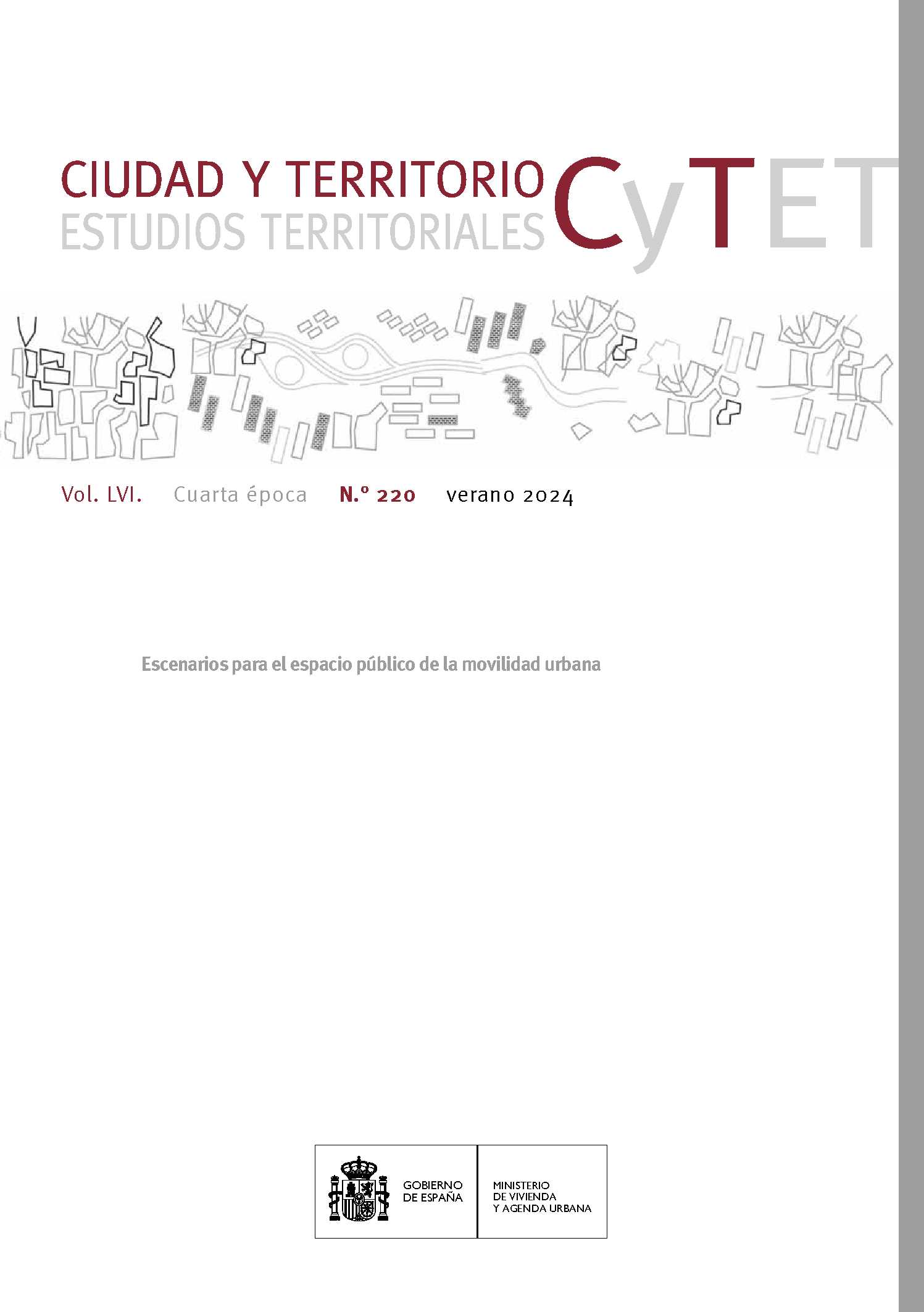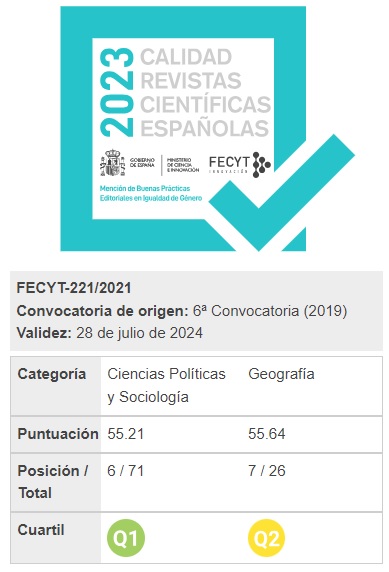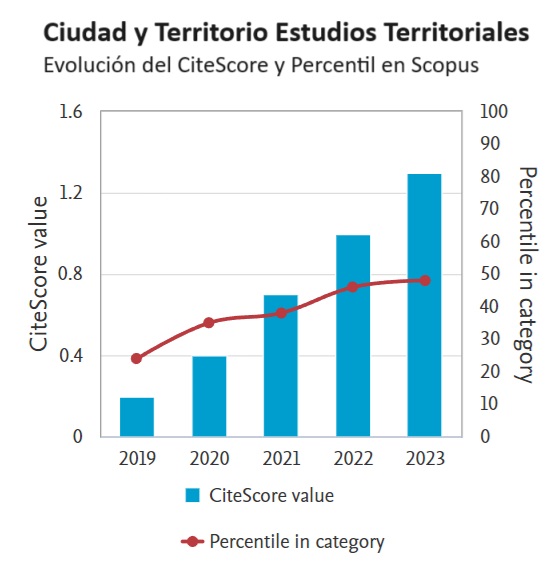Walkability and cardiovascular risk factor mortality in the city of Granada
DOI:
https://doi.org/10.37230/CyTET.2024.220.5Keywords:
Urban health, Walkability, Mortality, Citizen participation, Gender perspectiveAbstract
Urban environments influence health and are determinants in reducing inequalities. Walkability plays a crucial role in urban planning and health promotion. This study aims to assess the walkability of Granada and its association with cardiovascular disease mortality. Using a mixed-methods approach with citizen participation and ecological analysis across 183 census tracts, we calculated walkability indices (Walk Score©) and analyzed their association with mortality. Our findings revealed a preference for a pedestrian-friendly city and sustainable mobility. Quantitative results showed significant spatial differences in mortality based on Walk Score©, sex, and specific diseases. This mixed-methods approach enriched our understanding of walkability in Granada and its impact on cardiovascular health.
Downloads
References
BOER, R. & ZHENG, Y. & OVERTON, A. & RIDGEWAY, G. K. & COHEN, D. A. (2007): Neighborhood Design and Walking Trips in Ten U.S. Metropolitan Areas. American Journal of Preventive Medicine, 32(4), 298-304. https://doi.org/10.1016/j.amepre.2006.12.012
BORRELL, C. & MARÍ-DELL’OLMO, M. & SERRAL, G. & MARTÍNEZ-BENEITO, M. & GOTSENS, M. (2010): Inequalities in mortality in small areas of eleven Spanish cities (the multicenter MEDEA project): Health & Place, 16(4), 703-711. https://doi.org/10.1016/j.healthplace.2010.03.002
COL·LECTIU PUNT 6 (2019): Urbanismo feminista: Por una transformación radical de los espacios de vida. https://www.punt6.org/es/books/urbanismo-feminista/ ISBN: 978-84-92559-99-2, 224 páginas, español.
COL LECTIU PUNT 6 (ORTIZ ESCALANTE, S. & CIOCOLETTO, A. & FONSECA, M. & CASANOVAS, R. & VALDIVIA, B.) (2021): Movilidad Cotidiana con Perspectiva de Género: Guía metodológica para la planificación y el diseño del sistema de movilidad y transporte. http://scioteca.caf.com/handle/123456789/1725
DE COURRÈGES, A. & OCCELLI, F. & MUNTANER, M. & AMOUYEL, P. & MEIRHAEGHE, A. & DAUCHET, L. (2021): The relationship between neighbourhood walkability and cardiovascular risk factors in northern France. The Science of the Total Environment, 772, 144877. https://doi.org/10.1016/j.scitotenv.2020.144877
DÍEZ, E. & AVIÑÓ, D. & PAREDES-CARBONELL, J. J. & SEGURA, J. & SUÁREZ, Ó. & GEREZ, M. D. & PÉREZ, A. & DABAN, F. & CAMPRUBÍ, L. (2016): Una buena inversión: La promoción de la salud en las ciudades y en los barrios. Gaceta Sanitaria, 30, 74-80. https://doi.org/10.1016/j.gaceta.2016.04.015
DIEZ ROUX, A. V. & GREEN FRANKLIN, T. & ALAZRAQUI, M. & SPINELLI, H. (2007): Intraurban Variations in Adult Mortality in a Large Latin American City. Journal of Urban Health, 84(3), 319-333. https://doi.org/10.1007/s11524-007-9159-5
DIEZ ROUX, A. V. & MAIR, C. (2010): Neighborhoods and health: Neighborhoods and health. Annals of the New York Academy of Sciences, 1186(1), 125-145. https://doi.org/10.1111/j.1749-6632.2009.05333.x
DOVEY, K. & PAFKA, E. (2020): What is walkability? The urban DMA. Urban Studies, 57(1), 93-108. https://doi.org/10.1177/0042098018819727
FARIÑA-TOJO, J. (2019): La Agenda Urbana Española: Hacia una ciudad más saludable. En Ciudad y Territorio. Estudios territoriales: Vol. LI (Invierno 2019, pp. 753-764). https://oa.upm.es/62651/1/AUE_ciudad_saludable.pdf
FARIÑA-TOJO, J. & HIGUERAS, E. & ROMÁN, E. (2019): Ciudad Urbanismo y Salud. Documento Técnico de criterios generales sobre parámetros de diseño urbano para alcanzar los objetivos de una ciudad saludable con especial énfasis en el envejecimiento activo. https://www.sanidad.gob.es/areas/promocionPrevencion/entornosSaludables/local/estrategia/herramientas/docs/Ciudad_urbanismo_y_salud.pdf
FARIÑA-TOJO, J. & HIGUERAS, E. & ROMÁN, E. & POZO, E. (2022): Guía para planificar ciudades saludables. Ministerio de Sanidad, FEMP. https://www.sanidad.gob.es/areas/promocionPrevencion/entornosSaludables/local/estrategia/herramientas/docs/Guia_Planificar_Ciudades_Saludables.pdf
FORSYTH, A. (2015): What is a walkable place? The walkability debate in urban design. URBAN DESIGN International, 20(4), 274-292. https://doi.org/10.1057/udi.2015.22
GALARRAGA, P. & VIVES, M. & CABRERA-MANZANO, D. & URDA, L. & BRITO, M. & GEA-CABALLERO, V. (2018): La incorporación de la salud comunitaria en la planificación y la transformación del entorno urbano. Informe SESPAS 2018. Gaceta Sanitaria, 32, 74-81. https://doi.org/10.1016/j.gaceta.2018.08.001
GARCÍA-CALVENTE, M. DEL M. & MATEO-RODRÍGUEZ, I. & EGUIGUREN, A. P. (2004): El sistema informal de cuidados en clave de desigualdad. Gaceta Sanitaria, 18(4), 132-139. https://www.scielosp.org/pdf/gs/2004.v18suppl1/132-139/es // https://dialnet.unirioja.es/servlet/articulo?codigo=860227
HAEBERER, M. & LEÓN-GÓMEZ, I. & PÉREZ-GÓMEZ, B. & TÉLLEZ-PLAZA, M. & PÉREZ-RÍOS, M. & SCHIAFFINO, A. & RODRÍGUEZ-ARTALEJO, F. & GALÁN, I. (2020): Social inequalities in tobacco-attributable mortality in Spain. The intersection between age, sex and educational level. PLoS ONE, 15(9), e0239866. https://doi.org/10.1371/journal.pone.0239866
INDIA-ALDANA, S. & RUNDLE, A. G. & ZELENIUCH-JACQUOTTE, A. & QUINN, J. W. & KIM, B. & AFANASYEVA, Y. & CLENDENEN, T. V., KOENIG, K. L. & LIU, M. & NECKERMAN, K. M. & THORPE, L. E. & CHEN, Y. (2021): Neighborhood Walkability and Mortality in a Prospective Cohort of Women. Epidemiology (Cambridge, Mass.), 32(6), 763-772. https://doi.org/10.1097/EDE.0000000000001406
JACOBS, J. (2011): Muerte y vida de las grandes ciudades (Á. Abad & A. Useros, Trads.; 1a. edición en Capitán Swing Libros). Capitán Swing Libros. https://dialnet.unirioja.es/servlet/articulo?codigo=6408259 , ISBN: 9788493898502, 488 páginas, español traducido.
JAMES, P. & HART, J. E. & LADEN, F. (2015): Neighborhood walkability and particulate air pollution in a nationwide cohort of women. Environmental Research, 142, 703-711. https://doi.org/10.1016/j.envres.2015.09.005
JONES, A. C. & CHAUDHARY, N. S. & PATKI, A. & HOWARD, V. J. & HOWARD, G. & COLABIANCHI, N. & JUDD, S. E. & IRVIN, M. R. (2021): Neighborhood Walkability as a Predictor of Incident Hypertension in a National Cohort Study. Frontiers in Public Health, 9, 611895. https://doi.org/10.3389/fpubh.2021.611895
KERN, L. & PATRI, R. (2021): Ciudad feminista: La lucha por le espacio en un mundo diseñado por hombres. Bellatera. ISBN-10 : 8418684003, ISBN-13 : 978-8418684005, 185 páginas, español.
LANG, J. J. & PINAULT, L. & COLLEY, R. C. & PRINCE, S. A. & CHRISTIDIS, T. & TJEPKEMA, M. & CROUSE, D. L. & DE GROH, M. & ROSS, N. & VILLENEUVE, P. J. (2022): Neighbourhood walkability and mortality: Findings from a 15-year follow-up of a nationally representative cohort of Canadian adults in urban areas. Environment International, 161, 107141. https://doi.org/10.1016/j.envint.2022.107141
LAVIN, T. & HIGGINS, C. & METCALFE, O. & JORDAN, A. (2006): Health Impacts of the Built Environment: A Review. Institute of Public Health in Ireland. https://publichealth.ie/sites/default/files/resources/Health_Impacts_of_the_Built_Environment_A_Review.pdf
LESLIE, E. & SAELENS, B. & FRANK, L. &, OWEN, N. & BAUMAN, A.& COFFEE, N. & HUGO, G. (2005): Residents’ perceptions of walkability attributes in objectively different neighbourhoods: A pilot study. Health & Place, 11(3), 227-236. https://doi.org/10.1016/j.healthplace.2004.05.005
LO, R. H. (2009): Walkability: What is it? Journal of Urbanism: International Research on Placemaking and Urban Sustainability, 2(2), 145-166. https://doi.org/10.1080/17549170903092867
LÓPEZ-SÁNCHEZ, M. P. & ALBERICH, T. & AVIÑÓ, D. & FRANCÉS GARCÍA, F. & RUIZ-AZAROLA, A. & VILLASANTE, T. (2018): Herramientas y métodos participativos para la acción comunitaria. Informe SESPAS 2018. Gaceta Sanitaria, 32, 32-40. https://doi.org/10.1016/j.gaceta.2018.06.008
MARMOT, M. (2005): Social determinants of health inequalities. The Lancet, 365(9464), 1099-1104. https://doi.org/10.1016/S0140-6736(05)71146-6
MIRA, J. J. & CARRILLO, I. & NAVARRO, I. & GUILABERT, M. & VITALLER, J. & PÉREZ-JOVER, V. & AGUADO, H. (2018): Public participation in health. A review of reviews. Anales del Sistema Sanitario de Navarra, 41(1), 91-106. https://doi.org/10.23938/ASSN.0172
MONGIL JUÁREZ, D. (2012): Planificación urbana, regeneración urbana integral y participación ciudadana en Cataluña: Balance y retos de futuro. En La ciudad de abajo arriba. Aportaciones para la práctica y la teoría del urbanismo participativo (pp. 73-91). https://revistascientificas.us.es/index.php/HyS/issue/view/359
ORGANIZACIÓN DE LAS NACIONES UNIDAS. (2019): Revisión de las Perspectivas de la Población Mundial de 2019. https://population.un.org/wup/Country-Profiles/
POZUETA, J. & LAMÍQUIZ DAUDÉN, F. J. & PORTO SCHETTINO, M. (2013): La ciudad paseable: Recomendaciones para la consideración de los peatones en el planeamiento, el diseño urbano y la arquitectura. Madrid Cedex 2013. https://ceh.cedex.es/tienda/?product=la-ciudad-paseable
RIVERA DE LOS SANTOS, F. & RAMOS VALVERDE, P. & MORENO RODRÍGUEZ, C. & HERNÁN GARCÍA, M. (2011): Análisis del modelo salutogénico en España: Aplicación en salud pública e implicaciones para el modelo de activos en salud. Revista Española de Salud Pública, 85(2), 129-139. https://www.redalyc.org/pdf/170/17020112002.pdf
SAELENS, B. E. & HANDY, S. L. (2008): Built Environment Correlates of Walking: A Review. Medicine & Science in Sports & Exercise, 40(7), S550-S566. https://doi.org/10.1249/MSS.0b013e31817c67a4
SÁNCHEZ DE MADARIAGA, I. (2004): Urbanismo con perspectiva de género. Instituto Andaluz de la Mujer. https://www.juntadeandalucia.es/organismos/inclusionsocialjuventudfamiliaseigualdad/servicios/publicaciones/detalle/43632.html : ISBN 84-7921-101-6, 100 páginas, español.
SÁNCHEZ-VILLEGAS, P. & CABRERA-LEÓN, A. & GIL GARCÍA, E. (2021): Asociación entre la caminabilidad del barrio de residencia y la mortalidad por distintas causas en Andalucía. Gaceta Sanitaria, 35(3), 260-263. https://doi.org/10.1016/j.gaceta.2019.06.004
UNITED NATIONS DEPARTMENT OF ECONOMIC AND SOCIAL AFFAIRS, POPULATION DIVISION. (2021): Global Population Growth and Sustainable Development.
VALLS-LLOBET, C. (2020): Mujeres invisibles para la medicina: Desvelando nuestra salud. Capitán Swing.
WALK SCORE PROFESSIONAL. (2023): Walk Score Professional - For Your Project, Site or Mobile App. Walk Score Widget and Walk Score API. https://www.walkscore.com/professional/
WILKINSON, R. G. & MARMOT, M. (1998): The solid facts: Social determinants of health (EUR/ICP/CHVD 03 09 01; p. 32). WHO Regional Office for Europe. https://apps.who.int/iris/handle/10665/108082
WORLD HEALTH ORGANIZATION. (2021): One Health High-Level Expert Panel Annual Report 2021 (p. 35). WHO. https://www.who.int/publications/m/item/one-health-high-level-expert-panel-annual-report-2021
WORLD HEALTH ORGANIZATION. (2022): World health statistics 2022: Monitoring health for the SDGs, sustainable development goals. World Health Organization. https://apps.who.int/iris/handle/10665/356584
Published
How to Cite
Issue
Section
License
Copyright (c) 2024 Elena María Gras-García , Ainhoa Ruiz-Azarola

This work is licensed under a Creative Commons Attribution-NonCommercial-NoDerivatives 4.0 International License.
Considering the provisions of the current legislation on Intellectual Property, and in accordance with them, all authors publishing in CyTET give -in a non-exclusive way and without time limit- to the Ministry of Transport, Mobility and Urban Agenda the rights to disseminate, reproduce, communicate and distribute in any current or future format, on paper or electronic, the original or derived version of their work under a Creative Commons Attribution-NonCommercial-NoDerivative 4.0 license International (CC BY-NC-ND 4.0), as well as to include or assign to third parties the inclusion of its content in national and international indexes, repositories and databases, with reference and recognition in any case of its authorship.
In addition, when sending the work, the author(s) declares that it is an original work in which the sources that have been used are recognized, committing to respect the scientific evidence, to no longer modify the original data and to verify or refute its hypothesis. Author(s) also declare that the essential content of the work has not been previously published nor will it be published in any other publication while it is under evaluation by CyTET; and that it has not been simultaneously sent to another journal.
Authors must sign a Transfer of Rights Form, which will be sent to them from the CyTET Secretariat once the article is accepted for publication.
With the aim of promoting the dissemination of knowledge, CyTET joins the Open Journal Access (OA) movement and delivers all of its content to various national and international indexes, repositories and databases under this protocol; therefore, the submission of a work to be published in the journal presupposes the explicit acceptance by the author of this distribution method.
Authors are encouraged to reproduce and host their work published in CyTET in institutional repositories, web pages, etc. with the intention of contributing to the improvement of the transfer of knowledge and the citation of said works.








 Enlace a CyTET en Linkedin
Enlace a CyTET en Linkedin